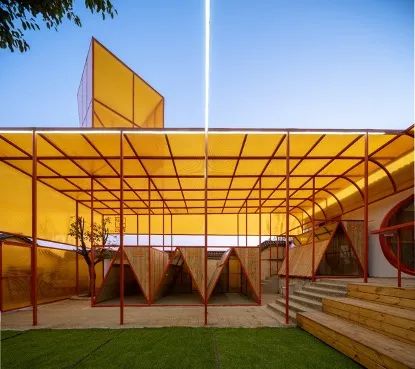设计师带你读懂当代戏剧:Hibiki
Designers take you through contemporary drama: Hibiki
01
设计师的看剧笔记
Designer's Note
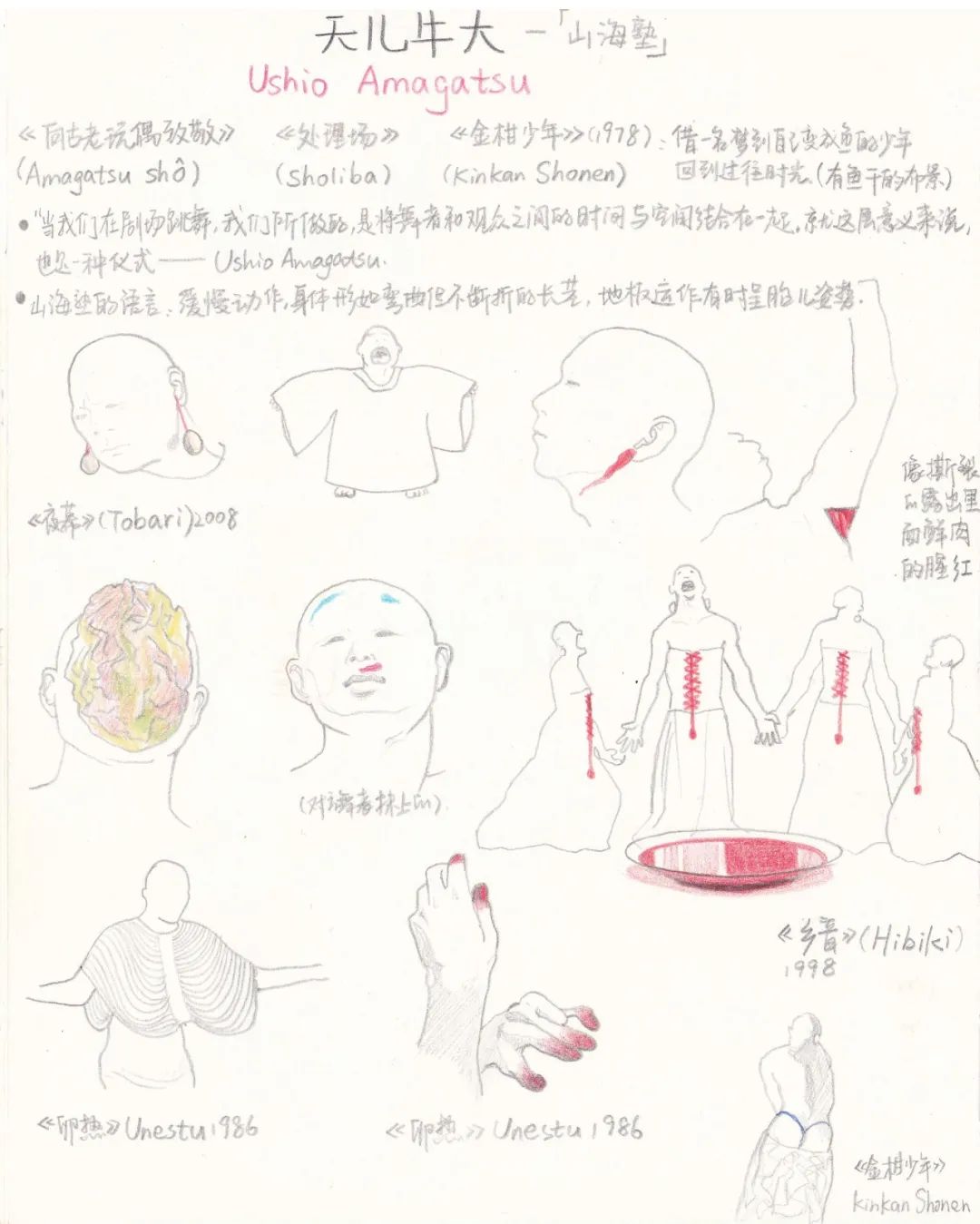
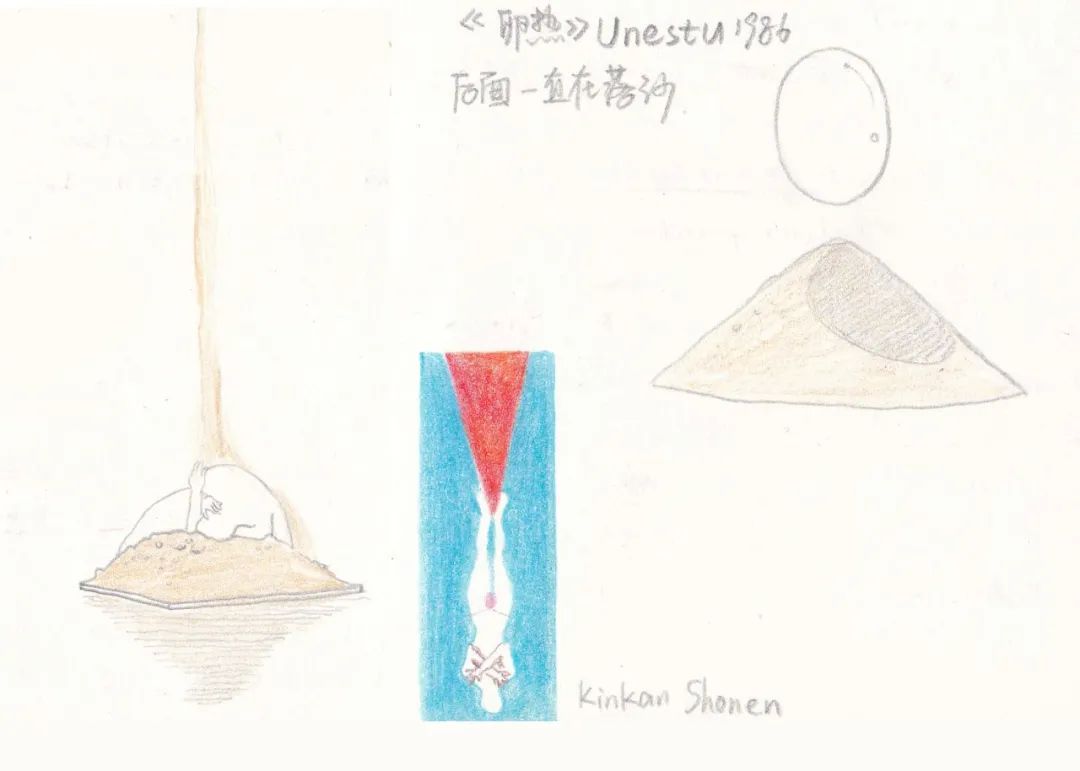
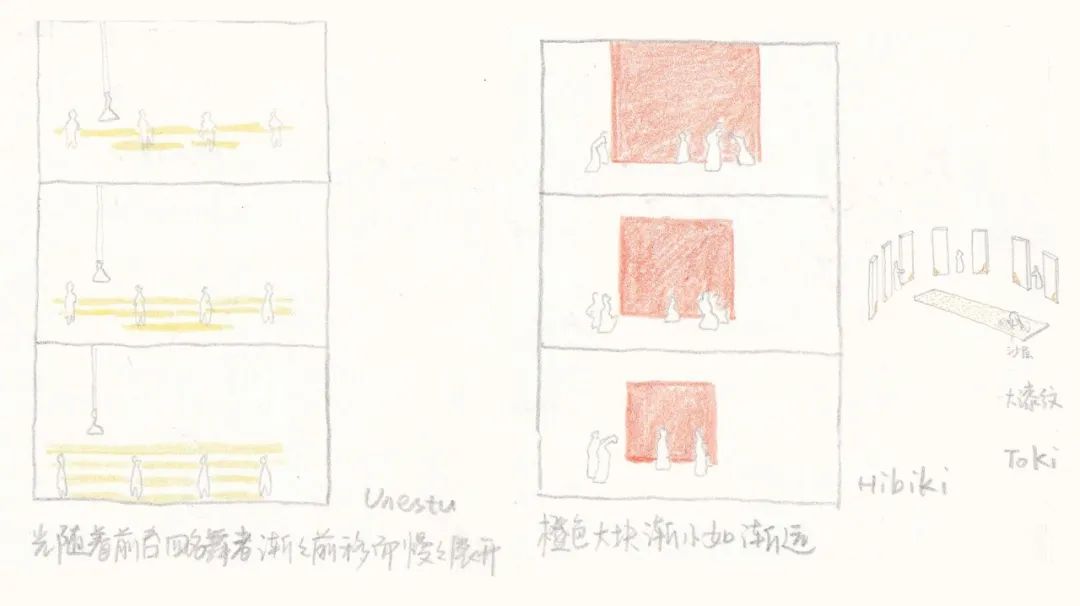
02
《HIBIKI》遥远的共鸣
The distant resonance of "HIBIKI"
《Hibiki》一开场水滴声撞破寂静,舞者身敷白粉,衣着白裙缓缓在舞台移动;场上摆放着大小不一的玻璃器皿,里面盛满了红色的颜料,如同血池一般。在这个神圣庄严的场地上,舞者似将身上的发肤、肉身、血液与舞台融为一体。他们通过肢体,演绎灵魂在冲击中崩解又再生的内心,祈祷在黑暗中离去,又盼望着光明的降临。
整部剧的舞者伴随充满力量的吟唱与电音的合成乐,通过身体的动线表达痛苦与悲伤,然后在气势磅礡的乐音,将原先被黑暗吞噬的白昼又重现在我们的面前,去表达对生命的理解。
The sound of water droplets broke the silence at the beginning of "Hibiki". The dancers were dressed in white powder and dressed in white skirts slowly moving on the stage; glassware of various sizes were placed on the stage, filled with red paint, like a pool of blood . In this sacred and solemn venue, the dancers seem to blend the body's hair, skin, body, and blood with the stage. Through their bodies, they interpret the inner heart of the soul disintegrating and regenerating in the impact, praying to leave in the dark, and looking forward to the coming of light.
The dancers in the whole play express pain and sadness through the movement of the body with powerful singing and electronic music. Then, in the majestic music, the day that was swallowed by darkness is brought back to us. Express the understanding of life.
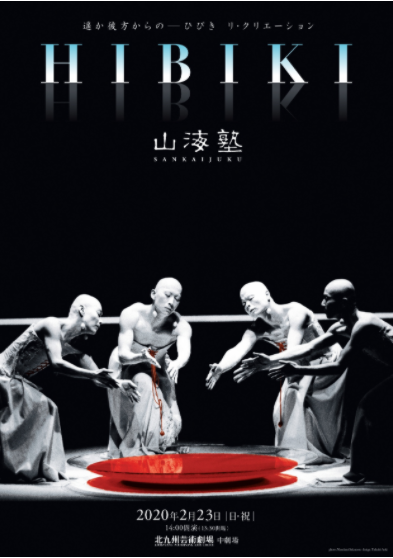
03
关于《HIBIKI》
About《HIBIKI》
03-1 导演和编舞: 天児牛大
Direction and Choreography: Ushio Amagatsu

天児牛大,Ushio Amagatsu,1949年出生于神奈川县横须贺市,是日本编舞家,他在1972年成为Butoh开创性团体Dairakudakan的共同创始人,并在3年后成立Butoh舞团Sankai Juku,他在其中担任负责人、艺术指导,编舞和舞者。Sankai Juku自1982年以来,其所有作品都在巴黎Théâtrede la Ville首映并共同制作,同时在40多个国家/地区,全球700个城市演出。
Ushio Amagatsu, born in Yokosuka, Kanagawa Prefecture in 1949, is a Japanese choreographer. He became the co-founder of Butoh’s pioneering group Dairakudakan in 1972, and established the Butoh dance group Sankai Juku 3 years later. Served as the person in charge, art director, choreographer and dancer. Since 1982, all of Sankai Juku's works have been premiered and co-produced at Théâtre de la Ville in Paris, and performed in more than 40 countries/regions and 700 cities around the world.
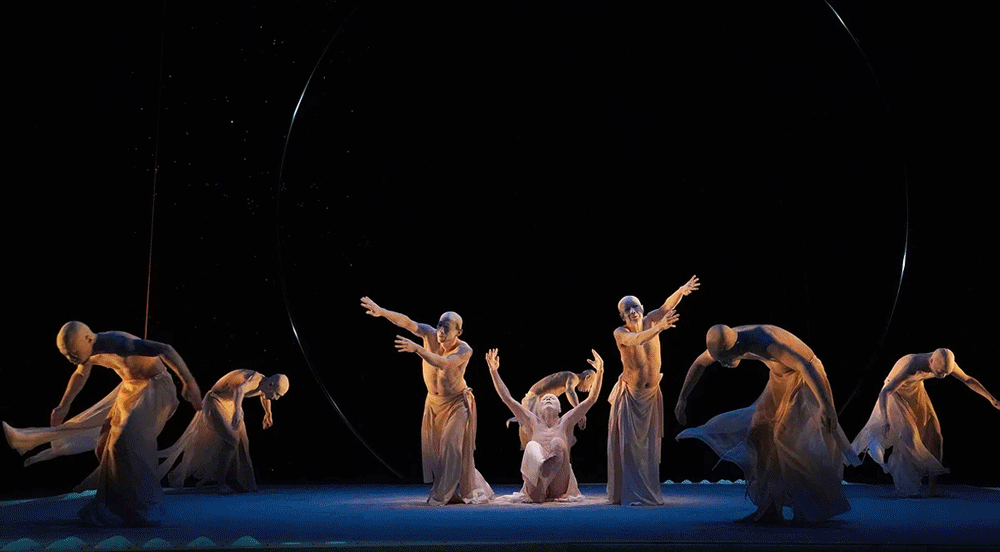
03- 2 舞种
Dance type
《Hibiki》的舞蹈类型属于日本的舞踏,而舞踏被称为buton或暗黑舞踏(暗黒舞踏 あんこくぶとう, ankoku butō, Butoh),是现代舞的一种形式,其发展的源头来源于,二战后日本舞蹈家土方巽(日语:土方巽)和大野一雄。他们意图通过舞蹈的形式,挑战西方对于表演、动作、和肢体的传统美学观点,追求肉体上的心灵解放和自由。舞踏的表演者通常全身赤裸并涂满白粉,通过呐喊、扭曲、匍匐、蟹足等元素去展现这个舞种。
随着舞踏的不断发展及传播,上世纪八十年代后,日本舞踏逐渐受到欧美舞蹈界的欢迎和重视,在国际上各个艺术节、舞蹈节中也常看见舞踏的表演。如今,日本舞踏已和Pina Bausch的舞蹈剧场(Tanztheater)及美国后现代舞蹈(Postmodern dance)并列为当代三大新舞蹈流派。
The dance type of "Hibiki" belongs to Japanese dance step, and dance step is called buton or dark dance step (暗黒舞步あんこくぶとう, ankoku butō, Butoh). It is a form of modern dance. Its development originated from World War II Later Japanese dancers Tukata Tatsumi (Japanese: Tukata Tatsumi) and Kazuo Ohno. They intend to challenge the traditional aesthetic views of performance, movement, and body in the West through the form of dance, and pursue physical spiritual liberation and freedom. The dancers of the dance step are usually naked and covered with white powder, and show the dance style by shouting, twisting, creeping, and crab feet.
With the continuous development and dissemination of the dance step, after the 1980s, the Japanese dance step has gradually been welcomed and valued by the European and American dance circles. It is often seen in various international art festivals and dance festivals. Nowadays, Japanese dance step has been listed as the three new contemporary dance genres alongside Pina Bausch's Tanztheater and American Postmodern dance.
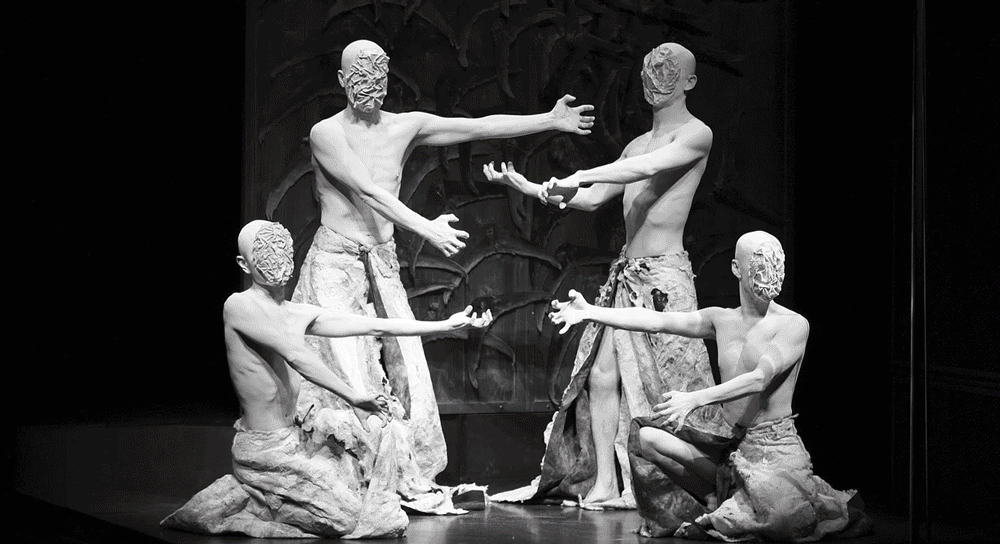
03-3 灵感来源
Source of inspiration
“Hibiki”的字面意思是共鸣,而在日文中译为声音。在创作时,天児牛大通过观察声音是如何对我们产生的影响,依此为创作灵感。在戏剧中通过水坠落的声音,背景音乐的变化,当场馆内的声音通过物体振动产生声波,在回弹后,碰撞、释放,传进我们的耳朵里,最后在我们体内产生影响,留下痕迹。
"Hibiki" literally means resonance, but it is translated as sound in Japanese. When creating, Tian'er Niu Da observes how the sound affects us, and uses this as his creative inspiration. In the drama, through the sound of falling water and the change of background music, when the sound in the venue generates sound waves through the vibration of objects, after rebounding, they collide and release, pass into our ears, and finally have an impact in our body, leaving behind trace.
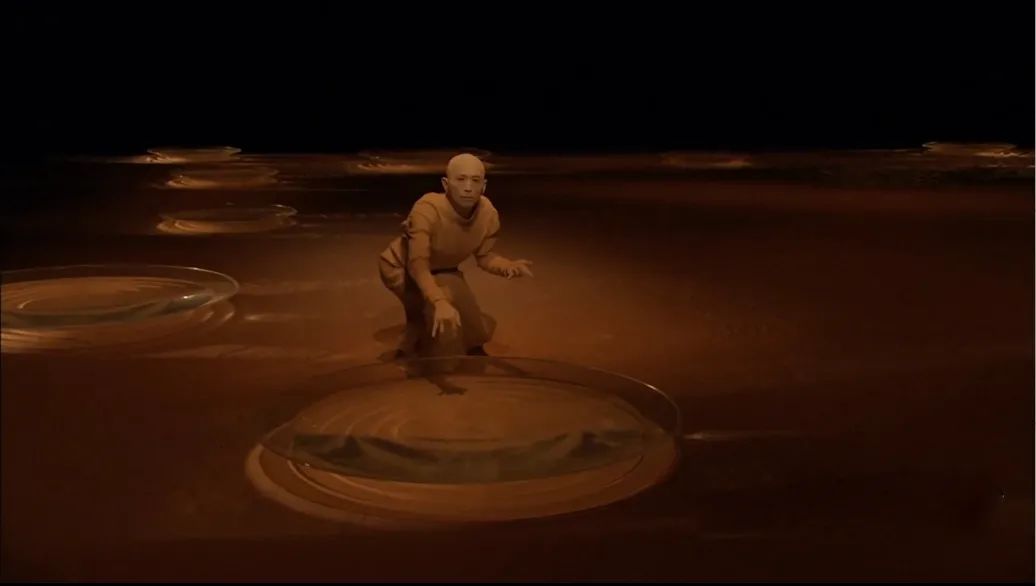
03-4 场景布置
Scene layout
《Hibiki》是由六名光头男性舞者组成,其中包括天児牛大自己,他们身着白色人体彩绘,在水滴,水盆和沙子中起舞。用这种隐喻的方式来表达对生命的理解,是天児牛大一贯的创作特色。
舞台布景中运用最原始简单的道具,例如通过水表达生命的起源,沙子意味死亡的信号。在天児牛大看来”“正是这种非常简单的方式鼓励了观众以各种不同的方式观看它们,而空间在演出的80至90分钟内会根据每个场景而做出变化。”去繁就简的舞台设计,定制般的场景变化,这样最真实的布景,让每一位观众在作品中做出自己的理解。
其中在灯光的运用上,天児牛大也有他独特的见解。通过在黑暗中追光的形式,为舞者人物的刻画出静谧的气氛,搭配暖色的橘色光源,忽远忽近营造紧张的氛围。
"Hibiki" is composed of six bald-headed male dancers, including Tian'er Niu Da himself, dressed in white body paint, dancing in water droplets, basins and sand. Expressing the understanding of life in this metaphorical way is a consistent creative feature of Tian'er Niu University.
The most primitive and simple props are used in the stage setting, such as expressing the origin of life through water, and sand means the signal of death. In the eyes of Tian'er Niu University, "It is this very simple way that encourages the audience to watch them in a variety of ways, and the space will change according to each scene within 80 to 90 minutes of the performance. "The stage design is simple and complicated, and the scene changes like customization. Only in this way can every audience make their own understanding in the work.
Among them, Tian'er Niu University also has his unique insights on the use of lighting. Through the form of chasing light in the dark, a quiet atmosphere is portrayed for the dancers, and the warm orange light source creates a tense atmosphere.
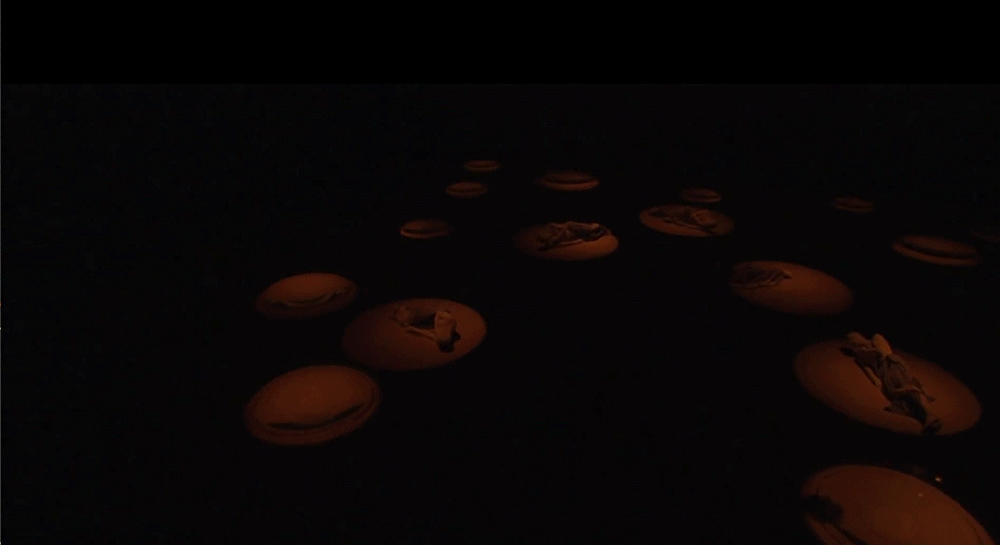
03-4 场景布置
Scene layout
《Hibiki》是由六名光头男性舞者组成,其中包括天児牛大自己,他们身着白色人体彩绘,在水滴,水盆和沙子中起舞。用这种隐喻的方式来表达对生命的理解,是天児牛大一贯的创作特色。
舞台布景中运用最原始简单的道具,例如通过水表达生命的起源,沙子意味死亡的信号。在天児牛大看来”“正是这种非常简单的方式鼓励了观众以各种不同的方式观看它们,而空间在演出的80至90分钟内会根据每个场景而做出变化。”去繁就简的舞台设计,定制般的场景变化,这样最真实的布景,让每一位观众在作品中做出自己的理解。
其中在灯光的运用上,天児牛大也有他独特的见解。通过在黑暗中追光的形式,为舞者人物的刻画出静谧的气氛,搭配暖色的橘色光源,忽远忽近营造紧张的氛围。
"Hibiki" is composed of six bald-headed male dancers, including Tian'er Niu Da himself, dressed in white body paint, dancing in water droplets, basins and sand. Expressing the understanding of life in this metaphorical way is a consistent creative feature of Tian'er Niu University.
The most primitive and simple props are used in the stage setting, such as expressing the origin of life through water, and sand means the signal of death. In the eyes of Tian'er Niu University, "It is this very simple way that encourages the audience to watch them in a variety of ways, and the space will change according to each scene within 80 to 90 minutes of the performance. "The stage design is simple and complicated, and the scene changes like customization. Only in this way can every audience make their own understanding in the work.
Among them, Tian'er Niu University also has his unique insights on the use of lighting. Through the form of chasing light in the dark, a quiet atmosphere is portrayed for the dancers, and the warm orange light source creates a tense atmosphere.
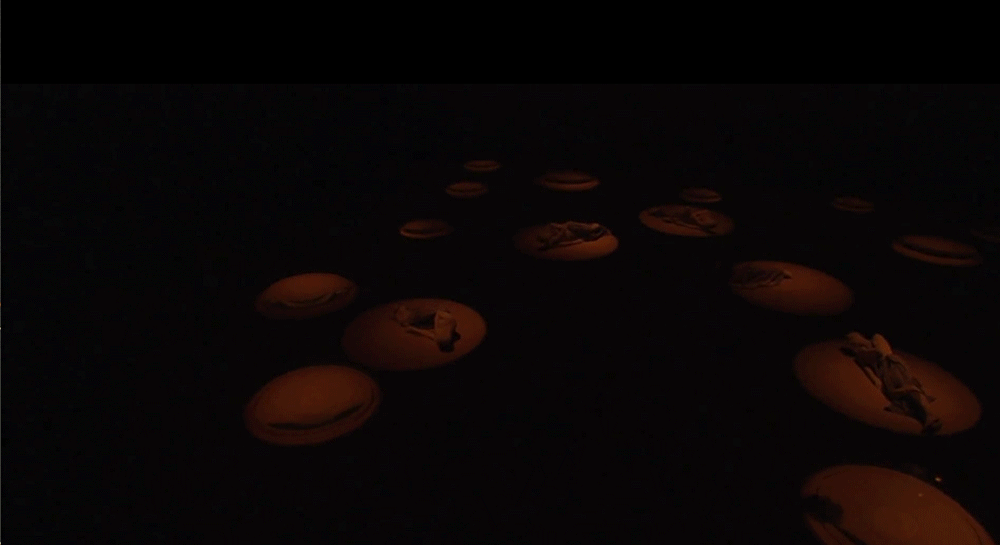
04
舞踏精神
舞踏是一种强调耐性、专注于「回归本真」的表达方式,它呈现出来的身体样态,一反人们对于舞蹈的既定观念,它藉由极缓慢的动作凸显内省及冥想的特质。舞踏没有固定的姿态或矫柔做作的优雅,取而代之的是肢体的扭曲与挤压,舞者的样貌因此看起来不太像个「人」,却呈现出卸下重重矫饰的人类原始本能的状态,怵目惊心且一点儿也不赏心悦目,是针对「美」的反动表达。
舞踏最引人注目的就是化白妆的光头舞者。白妆是为了将舞者的个人身份,即个体的自我抹去,呈现最纯粹的生命本质,光头则代表「回归原胎」。舞者有时也会戴上假发、穿着不同的服饰,化身小孩、女人、老者或疯子等「社会边缘人」,其颓废滑稽的模样不禁使人忆及已故日本大导演黑泽明(1910-1998)片中游魂般的浪人。此外,白粉会在舞动的过程中飘散,象征生命的流逝,显现死亡之姿。
Dance step is an expression that emphasizes patience, concentration and "returning to the truth." The body it presents is contrary to people's established concept of dance. It highlights the characteristics of introspection and meditation through extremely slow movements. Dance pedals do not have a fixed posture or soft and artificial elegance. Instead, they are distorted and squeezed by their limbs. Therefore, the dancer's appearance does not look like a "human", but it presents the original human instincts without heavy pretensions. Shocking and not pleasing at all, it is a reaction against "beauty."
The most striking thing about Wuta is the bald dancer with white makeup. White makeup is to erase the dancer's personal identity, that is, the individual's self, and present the purest life essence, while the bald head represents "return to the original womb." Dancers sometimes wear wigs and different costumes, incarnate as "marginal people" such as children, women, old men, or lunatics. Their decadent and funny appearance can not help but remind people of the late Japanese director Akira Kurosawa (1910- 1998) The wandering ronin in the film. In addition, the white powder will float in the process of dancing, symbolizing the passing of life and showing the posture of death.
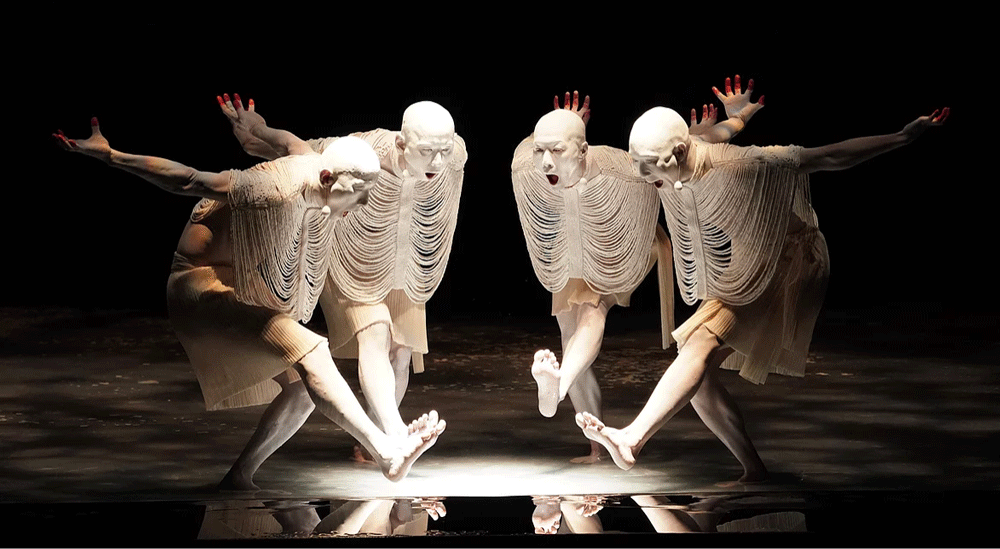
致谢
Credits
导演和编舞 / Direction and Choreography:
天児牛大 Ushio Amagatsu
音乐 / Music
Takashi Kako /
Yoicihro Yoshikawa
联合演出 /Collaboration:
Ushio Amagatsu / Semimaru / Sho Takeuchi / Akihito Ichihara / Ichiro Hasegawa / Dai Matsuoka
首次展演 / First performance:
Theatre de la Ville,Paris in 1998
演出时长 / Duration:
1h 20min, one intermission
关于设计师
About the Designer
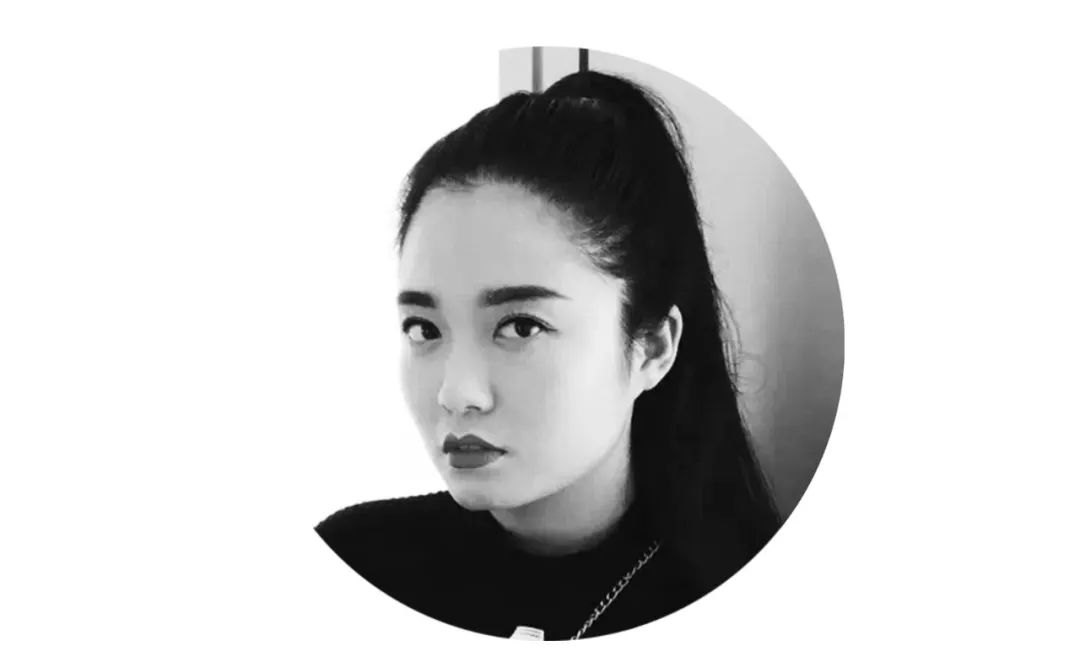
廖青
莫方 Eating Lab+Gallery+Theater 主理人
荷兰皇家艺术学院室内建筑专业
(Interior Architecture) 研究生
清华大学美术学院环境艺术设计系室内设计专业 本科
Liao Qing
Mofang Eating Lab Gallery Theater Principal
Graduate student of Interior Architecture,
Royal Academy of Arts in the Netherlands
Bachelor of Interior Design, Department of Environmental Art Design, School of Fine Arts, Tsinghua University

